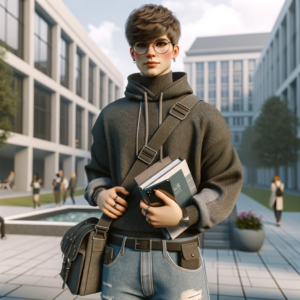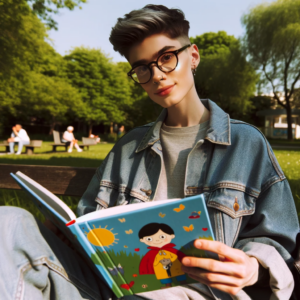Imaginary friends are one of the weirder forms of pretend play in childhood. But the research shows that imaginary friends actually help children understand the other people around them and imagine all the many ways that people could be.
—Alison Gopnik, Scientific American, 2009
Like most of the strategies that work well with my teacher candidates—college students studying to be teachers—the original idea came from a K–12 classroom teacher. An example is The Fictitious Student. I learned about the value of having a pretend student in class from Lisa, a third-grade teacher who regularly serves as a cooperating teacher in our program. Lisa has a great sense of humor, a disposition she brings to many dimensions of her teaching, but especially the way she runs her classroom.
Case in point: Felix and Poppy. Felix and Poppy are perpetual third graders in Lisa’s class. If the school year starts with an even number, Felix is the student; when it’s an odd-number start, it’s Poppy’s turn. On the first day of school, Lisa talks about Felix/Poppy as casually as if her third graders have known their classmate for years.
“Hey, everyone,” Lisa will say. “I just want to point out how Poppy read the message on the board and followed the steps perfectly. She found her name on her locker in the hall and put her backpack in there, and now she’s sitting at her desk decorating her name tag. Rock on, Poppy.”
I’ve been in Lisa’s room on the first day of school, so I’ve seen the “real” third graders react. Some kids get it right away, some kids don’t, but by the end of the first week, everyone’s on the same page. Poppy is their imaginary classmate, and they’re going to hear her name often. Lisa told me that after a few weeks, without fail, some of her kids are working Poppy into conversations, asking, “What did Poppy get for an answer, Ms. Davis?” or saying, “I want to sit next to Poppy at lunch,” or “I’ll be partners with Poppy.” It can get to be a thing.
Lisa’s a pro at holding the line, though, and imaginary students are important players in the way she builds and maintains the social, emotional, and academic qualities of her classroom community. Felix/Poppy are characters in the story of the classroom, lifting up different identities, emphasizing important habits of thinking, reinforcing norms and expectations, navigating challenges, and celebrating wins.
Recently, I decided to experiment with adding a fictitious student to a children’s literature course I was teaching. I named my student Stevie and decided I would give them gender-neutral pronouns. An extra incentive for having Stevie join Children’s Literature is that the class is fully online and asynchronous. Given the course format, I decided that an imaginary student would be a helpful sidekick for planning and delivering the recorded mini-lectures my students were required to watch as part of their weekly work.
To introduce Stevie, I needed a visual I could incorporate into the Google slides I prepared for screencasting, and for help with that, I turned to ChatGPT. In my initial prompt, I asked, “I’d like a digital image of a nonbinary college student,” and here is what DALL-E produced:

I debuted Stevie in my Week 1 screencast, showing them on a slide titled “Meet Stevie,” and then explaining, “This is Stevie, a student in EDU 33X this semester. Stevie has graciously allowed me to use them to explain, highlight, and extend aspects of our course this semester. This week, Stevie and I are going to walk you through the digital book talk assignment.”
From there, I designed a series of slides that explained the assignment details from Stevie’s perspective, starting with, “Stevie is prepping and preparing the first digital book talk. Their first step is studying what this semester-long assignment is all about.”
To stay mindful of ways I can use Stevie to good effect, I regularly think about how I would recruit students in a face-to-face setting. For instance, in a “live” class, I would often ask a student who had done particularly good work on an assignment to talk us through their process: What was challenging? How did a breakthrough happen? Or when we’d finished some small-group work and were back together, I would highlight an idea or strategy I’d heard a group discussing or using so the whole class would benefit from it.
In a virtual class, I enlist Stevie in similar ways. So far, I’ve used them in a Q&A session about their reaction to Big, the 2024 Caldecott Award winner, written and illustrated by Vashti Harrison. I’ve interviewed Stevie about how they find books to read that comply with guidelines for the course’s book file project. And I’ve used Stevie’s assignment submissions to highlight a detail that shows evidence of how they are integrating new learning into their thinking or planning. (In case you’re curious, Stevie’s work is Suzy-generated, because “doing the student work” is an important part of my planning practice—it helps me work out the bugs and prepare to give feedback.)
For each new role Stevie serves in, I ask DALL-E to generate a matching image.




These days, with AI tools storming the world, the line between imaginary and real is quickly blurring, but adding Stevie to my course felt useful, even natural, right from the start. And my college students are responding a lot like Lisa’s third graders did when they were introduced to Felix/Poppy, embracing them quickly. For instance, in one student’s digital book talk about Rosa, by Nikki Giovanni and Bryan Collier, he wrote, “I used Stevie’s idea to do an online search for teaching guides when I was looking for literature-based activities to use with Rosa.” Another student, in her discussion board post, wrote, “After reading about books as windows and mirrors, I think I need to write a book that would be a mirror for Stevie—that sounds really meta.”
So Stevie is about a few things: using humor to engage students, mediating teaching and learning through a proxy, and giving students (whether they’re real or pretend) leadership opportunities. I am excited about the possibilities for using AI tools to reproduce, amplify, and extend best practices in all the kinds of classrooms where we teach today.


